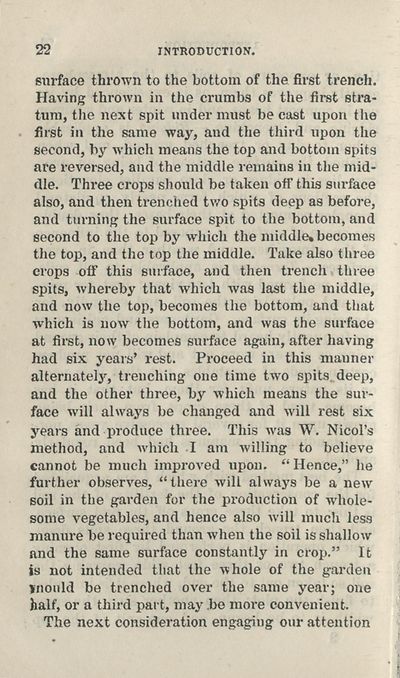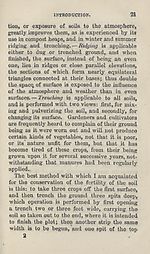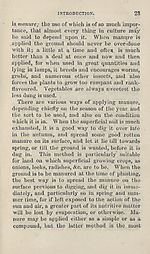Occupations > Abercrombie's improved practical gardener; with a monthly calendar for the flower garden
(26)
Download files
Complete book:
Individual page:
Thumbnail gallery: Grid view | List view

22
INTRODUCTION.
surface thrown to the bottom of the first trench.
Having thrown in the crumbs of the first stra¬
tum, the next spit under must be cast upon the
first in the same way, and the third upon the
second, by which means the top and bottom spits
are reversed, and the middle remains in the mid¬
dle. Three crops should be taken off this surface
also, and then trenched two spits deep as before,
and turning the surface spit to the bottom, and
second to the top by which the middle, becomes
the top, and the top the middle. Take also three
crops off this surface, and then trench > three
spits, whereby that which was last the middle,
and now the top, becomes the bottom, and that
which is now the bottom, and was the surface
at first, now becomes surface again, after having
had six years’ rest. Proceed in this manner
alternately, trenching one time two spits, deep,
and the other three, by which means the sur¬
face will always be changed and will rest six
years and produce three. This was W. Nicol’s
method, and which I am willing to believe
cannot be much improved upon. “ Hence,” he
further observes, “there will always be a new
soil in the garden for the production of whole¬
some vegetables, and hence also will much less
manure be required than when the soil is shallow
and the same surface constantly in crop.” It
is not intended that the whole of the garden
mould be trenched over the same year; one
half, or a third part, may .be more convenient.
The next consideration engaging our attention
INTRODUCTION.
surface thrown to the bottom of the first trench.
Having thrown in the crumbs of the first stra¬
tum, the next spit under must be cast upon the
first in the same way, and the third upon the
second, by which means the top and bottom spits
are reversed, and the middle remains in the mid¬
dle. Three crops should be taken off this surface
also, and then trenched two spits deep as before,
and turning the surface spit to the bottom, and
second to the top by which the middle, becomes
the top, and the top the middle. Take also three
crops off this surface, and then trench > three
spits, whereby that which was last the middle,
and now the top, becomes the bottom, and that
which is now the bottom, and was the surface
at first, now becomes surface again, after having
had six years’ rest. Proceed in this manner
alternately, trenching one time two spits, deep,
and the other three, by which means the sur¬
face will always be changed and will rest six
years and produce three. This was W. Nicol’s
method, and which I am willing to believe
cannot be much improved upon. “ Hence,” he
further observes, “there will always be a new
soil in the garden for the production of whole¬
some vegetables, and hence also will much less
manure be required than when the soil is shallow
and the same surface constantly in crop.” It
is not intended that the whole of the garden
mould be trenched over the same year; one
half, or a third part, may .be more convenient.
The next consideration engaging our attention
Set display mode to:
![]() Universal Viewer |
Universal Viewer | ![]() Mirador |
Large image | Transcription
Mirador |
Large image | Transcription
| Antiquarian books of Scotland > Occupations > Abercrombie's improved practical gardener; with a monthly calendar for the flower garden > (26) |
|---|
| Permanent URL | https://digital.nls.uk/121881531 |
|---|
| Description | Thousands of printed books from the Antiquarian Books of Scotland collection which dates from 1641 to the 1980s. The collection consists of 14,800 books which were published in Scotland or have a Scottish connection, e.g. through the author, printer or owner. Subjects covered include sport, education, diseases, adventure, occupations, Jacobites, politics and religion. Among the 29 languages represented are English, Gaelic, Italian, French, Russian and Swedish. |
|---|

